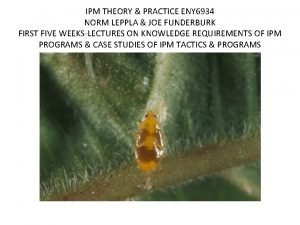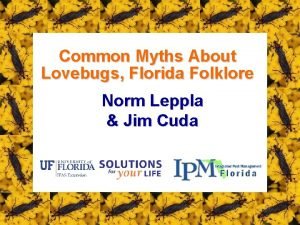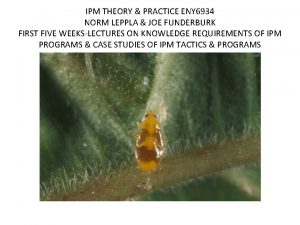Where in the World is Idris Leppla Idris











![Anxiety “The chief characteristic of [psychoneurotic disorders] is anxiety, which may be directly felt Anxiety “The chief characteristic of [psychoneurotic disorders] is anxiety, which may be directly felt](https://slidetodoc.com/presentation_image_h2/01f36ca2e2b7d12b68a5ab2b8cf35634/image-12.jpg)











- Slides: 23

Where in the World is Idris Leppla? Idris Leppla is a first year Resident in Psychiatry at Johns Hopkins University. She graduated from UC Irvine School of Medicine in 2014, where she received the UC Medical Humanities Consortium award for humanitiesrelated research. What follows is her project.

A look at Blanche Du. Bois from psychiatric and dramatic perspectives: A medical student’s journey Idris Leppla, MD Johns Hopkins University School of Medicine Johanna Shapiro, Ph. D. University of California, Irvine School of Medicine

A Streetcar Named Desire: The Characters Blanche Du. Bois is the sister of Stella Kowalski , who is married to Stanley Kowalski

A Streetcar Named Desire: The Plot • Blanche arrives penniless and poor after Belle Reve (her family’s Southern plantation home) is foreclosed. She takes refuge in her sister’s (Stella’s) home only to encounter Stanley (Stella’s husband), and the two of them clash from the beginning. Blanche’s troubled character comes more and more to the surface as aspects of her past unveil themselves and Stanley becomes increasingly nasty toward Blanche tries to redeem her situation by seducing Mitch, a genuinely nice friend of Stanley’s, but as Mitch finds out more about Blanche, he rejects her. At the end, Blanche is shuttled to a mental asylum by a psychiatrist.

Enduring Allure Ø The play debuted on Broadway in 1947 Ø Won the Pulitzer Prize and Drama Critics Circle Award Ø Tennessee Williams’ goal: “To show the complexity of human experience that exists within one individual” (Kazan, 1993, Special Features Commentary). Ø Contemporary readers relate to Blanche’s alcoholism, traumas (loss of home, family deaths, sexual abuse), anxiety, fragile personality

Why Idris was drawn to this play Tennessee Williams’ A Streetcar Named Desire is a rich template for analyzing psychiatric illness Ø Blanche is often used as prototype of narcissistic personality disorder, a psychiatric diagnosis with a 6. 2% prevalence in community samples Ø Ø As a future psychiatrist, Idris was interested in the accuracy of Blanche’s diagnosis; as well as in how treatment might differ between the late 1940 s/50 s and today 2014 1950

More to Blanche? Ø But Idris also wondered: Was there more to Blanche? Was her situation more complex than the reductive way she is often used in psychiatric literature? Ø In an interview, Tennessee Williams once said, “I don’t believe in villains or heroes—only right or wrong ways that individuals have taken, not by choice but by necessity or by certain stilluncomprehended influences in themselves, their circumstances, and their antecedents” (Williams, 2004). Ø Williams intended Blanche to be more than a pathology

Description of methodology Ø Ø Ø Close reading of play – writing out on flashcards each quote relevant to a psychiatric disorder Generating hypotheses/ideas, discussing these with faculty advisor, doing historical research into diagnostic and treatment beliefs of the 1940 s, meaning of Southern belle etc. Watching movie with Vivian Leigh Seeing a live performance of the play – Yale Rep Theater October 2013 Each encounter with the play enhanced its complexity

Conclusions are complex: Blanche’s “Diagnoses” Probably narcissistic/histrionic personality disorder AND ALSO Ø Ø Anxiety/panic disorder Alcoholism PTSD A feast of psychiatric dysfunction Ø Widely believed that Williams modeled Blanche on his sister Rose who struggled with mental health issues and was eventually incapacitated after a lobotomy l not surprising to discover evidence of psychiatric disorders in this character

Personality Disorder Ø Theodore Millon, one of first psychologists to write extensively about personality disorders, described Blanche as follows: “The Narcissist, with fragile and grandiose self-approval, the histrionic, always in the thick of some drama, desperate to be the center of attention”

Cluster B Personality Disorders Ø Narcissistic personality disorder l l l Ø Feelings of superiority, grandiosity: Blanche (and by extension Stella) is better than everyone, especially than Stanley (“brute-like”) Need to be admired – Blanche seeks constant approval for her appearance Callousness, lack of empathy – Blanche is unable to see perspectives other than her own (“I stayed at Belle Reve and tried to hold it together… all the burden fell on my shoulders”); constantly seeks the “kindness” of others, while never reciprocating Histrionic personality disorder l l Want to be center of attention – Blanche dominates the room Extreme emotionality, dramatic – Blanche speaks with “feverish vivacity, ” “laughs breathlessly” Seductive behavior (Blanche’s seduction of Mitch; “cultivated companionship”) Act out a role (Blanche tries to embody the Southern belle)
![Anxiety The chief characteristic of psychoneurotic disorders is anxiety which may be directly felt Anxiety “The chief characteristic of [psychoneurotic disorders] is anxiety, which may be directly felt](https://slidetodoc.com/presentation_image_h2/01f36ca2e2b7d12b68a5ab2b8cf35634/image-12.jpg)
Anxiety “The chief characteristic of [psychoneurotic disorders] is anxiety, which may be directly felt and expressed or which may be unconsciously and automatically controlled by the utilization of various psychological defense mechanisms” (DSM, 1952) Ø Chronic irritability, excessive worrying and inner tension; always anticipating disaster – Blanche displays all of these symptoms Ø Like many people suffering from anxiety, Blanche selfmedicates with alcohol (“Now don’t get worried, your sister hasn’t turned into a drunkard…” and hydrotherapy (“I take hot baths for my nerves”) Ø

Post-Traumatic Stress Disorder Scholars have argued that Blanche suffers from PTSD Blanche experienced a series of traumas: l the suicide of her gay husband (initial trauma, which involuntarily intrudes – “the boy died”); l losing her plantation home due to family debt; l the death of her parents and extended family at Belle Reve; l being exiled from her small town after having a relationship with a 17 yr old school boy when she was a teacher Ø Blanche experiences involuntary reliving of traumatic events (“I, I, I took the blows in my face and my body! All those deaths. The long parade to the graveyard. ” ) l Dissociation (retreats into fantasies of Southern belle) l Guilt, shame (“You disgust me” said to Allan Gray), denial l Shattering of the self l Compulsion to repeat the story of trauma Ø Ø

Treating Blanche’s Diagnoses – Anxiety Then and Now: Modulate anxiety with medications. Ø Treatments available in 1953 for symptoms of anxiety included barbiturates Ø l l Ø potassium bromide and amylobarbitone sodium for “substantial relief of tension” pentobarbital, a short acting barbiturate, “for the management of reactions of acute panic” Today, benzodiazepines have largely replaced clinical role of barbiturates l patients with anxiety disorder prescribed combination of • a short-acting anxiolytic medication for acute attacks and • a selective-serotonin reuptake inhibitor, to lower baseline anxiety

Treating Blanche’s Diagnoses – Cluster B Personality Disorders Ø By the 1950 s, the concept of "character disorders" widely accepted within the psychoanalytic community l l Ø Psychoanalytic clinicians distinguished character disorders from the more severe forms of mental illnesses (psychosis) Character disorders not viewed as legitimate mental illnesses Seen as weaknesses of character or willfully deviant behavior caused by problems in a person's upbringing Patients treated in psychoanalysis where they typically got worse Today, Blanche might seek out long-term therapy for personality disorders l l Menninger Clinic in Houston costs $2000/day - not covered by insurance Dialectical Behavioral Therapy re-trains people to manage unpleasant emotions and provides skills to express frustration

Treating Blanche’s Diagnoses PTSD Ø After WWII, PTSD was called combat exhaustion or battle fatigue Ø Treatment consisted of rest in a safe place, and experimentation with sodium pentathol to deal with repressed battlefied experiences Ø Today, Blanche’s PTSD might be treated through l l l Prolonged exposure therapy - recall traumatic memories in a controlled fashion so that clients eventually regain mastery of their thoughts and feelings Cognitive processing therapy - places greater emphasis on cognitive strategies to help people alter erroneous thinking that has emerged because of the event Stress-inoculation training - techniques to manage and reduce anxiety, such as breathing, muscle relaxation and positive self-talk Eye-movement desensitization and reprocessing, or EMDR Medications, specifically selective serotonin reuptake inhibitors

Diagnoses and Treatments Ø Diagnoses have become more sophisticated l l More behavioral Less Freudian, psychodynamic Ø Treatment modalities have improved l l Evidence-based More effective medications

The Play vs. the Case History Ø Does the play illuminate anything in a way that a case history does not? Ø Increase empathy? Add insight? Ø Is Blanche more than a collection of diagnoses and symptoms?

Blanche the Diagnosis vs. Blanche the Character Psychiatry tends to seek out the identified patient, the source of all problems Ø This was true in the 1940 s and it is largely true today Ø The patient is pathologized and treatments are directed at reintegrating the patient into society Ø Blanche certainly has psychiatric issues that need treatment; but also in need of treatment was a society in which Ø l l l Women were perceived as ornaments in which women’s physical attractiveness and culture were the primary tools they had for attracting a mate (and therefore survival) Men set the tone in relationships and called the shots

The Southern Belle Ø 1950 s and in the South, “a woman’s future depended on the marriages they made for themselves” (Smith, 2002) Ø Blanche tries to be the perfect Southern belle for her own survival (If she can convince Mitch to marry her, she will escape poverty and homelessness)

Family/Relational Dynamics Ø Family dynamics were also at play Stella colludes with Blanche’s behavior, while also abandoning her (by fleeing to a different state and marriage; by refusing to witness to her “morbid” memories) l Stanley uses his sexuality, power, and male dominance to “crush” Blanche, thus securing his relationship with Stella by eliminating a potential competitor l

Conclusion – Who is Blanche? Ø A troubled woman, but also someone who has survived using the resources and skills available to her as a product of her historical time (1940 s) and place (South) Both “mad” and resilient Ø Surprising self-awareness (“After the death of Allan, intimacies with strangers was all I seemed to be able to fill my empty heart with”); and even self-deprecating humor (“I shall die of eating an unwashed grape”) Ø Like most of us, driven by desire and longing for something better, something safer, something more Ø In need of treatment, but also perhaps meriting the kindness she relied on and even in some respects the admiration she desperately craved Ø

Conclusion Ø As a result of this project, l Idris’ appreciation both for the value and the limits of psychiatric diagnosis was enhanced, l as was her appreciation for the human story, which cannot be told through the DSM-V manual
 Prophte
Prophte Dr mona hassan
Dr mona hassan Idris winarno
Idris winarno Dennis kozlowski tyco
Dennis kozlowski tyco Fern hunt
Fern hunt Idris winarno
Idris winarno Testimonial definition literature
Testimonial definition literature Idris winarno
Idris winarno Các châu lục và đại dương trên thế giới
Các châu lục và đại dương trên thế giới Từ ngữ thể hiện lòng nhân hậu
Từ ngữ thể hiện lòng nhân hậu Diễn thế sinh thái là
Diễn thế sinh thái là Vẽ hình chiếu vuông góc của vật thể sau
Vẽ hình chiếu vuông góc của vật thể sau Frameset trong html5
Frameset trong html5 Thế nào là giọng cùng tên? *
Thế nào là giọng cùng tên? * Phép trừ bù
Phép trừ bù Lời thề hippocrates
Lời thề hippocrates Khi nào hổ mẹ dạy hổ con săn mồi
Khi nào hổ mẹ dạy hổ con săn mồi đại từ thay thế
đại từ thay thế Chụp phim tư thế worms-breton
Chụp phim tư thế worms-breton Quá trình desamine hóa có thể tạo ra
Quá trình desamine hóa có thể tạo ra Công thức tính thế năng
Công thức tính thế năng Thế nào là mạng điện lắp đặt kiểu nổi
Thế nào là mạng điện lắp đặt kiểu nổi Dạng đột biến một nhiễm là
Dạng đột biến một nhiễm là Biện pháp chống mỏi cơ
Biện pháp chống mỏi cơ













































